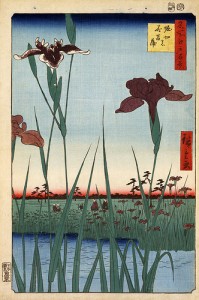The programme for the ASA-CSSA-SSSA International Annual Meetings in November is up. The genetic resources sessions look very solid, as ever. And the prestigious Calvin Sperling Memorial Lecture is to be given by our friend, colleague and occasional contributor Robert Hijmans on a topic we’ve blogged about often here, climate change and agrobiodiversity.
Fetured: Agri-intellectual fights back
Mike Huben busts the drowning turkey myth, which I should really have checked myself:
But I wouldn’t be in any rush to compliment them on numbers or anecdotes: the turkey drowning story is an urban myth. His calculations on the amount of table scraps needed for fertilizer make all sorts of ridiculous, inefficient assumptions.
And there’s more:
The American Enterprise Institute is a propaganda organ for conservative corporate capitalism. They don’t really care about Pollan’s book…
Read the whole comment. And also the original article’s author on that turkey story:
The turkey story is a result of an interview with Mr. Nieman, the incident occurred about 2 miles from my mother’s childhood home, about 10 miles from where we live now. It’s interesting that the word of the farmer who suffered the loss of his livelihood is not good enough. Mr. Niemann has no reason to lie-neither does my mother, who remembers the incident. And 50 years ago, my grandfather was among the first in our community to build terraces to protect the soil on the farm we still farm. The farm produces more now than it did then. That would be the very definition of sustainability.
Old maps used to track down hops in Sweden
![]() I’ve done a fair amount of reading and thinking about the theory and practice of germplasm collecting in my time, but I don’t think I’ve ever come across an example similar to the one described in a recent paper in Genetic Resources and Crop Evolution. 1
I’ve done a fair amount of reading and thinking about the theory and practice of germplasm collecting in my time, but I don’t think I’ve ever come across an example similar to the one described in a recent paper in Genetic Resources and Crop Evolution. 1
In it, Swedish researchers describe how they took advantage of a couple of interesting quirks in the history of Sweden to devise what I think is a pretty novel strategy for sampling agrobiodiversity. They were interested in collecting germplasm of hops (Humulus lupulus) for a new genebank that’s under development. Now, the thing is that, although this crop is no longer grown in Sweden now, for 400 years from 1442 doing so was compulsory, in order to guarantee sufficient domestic production for beer-making. Very sensible, too.
Initially, all peasants were required to grow at least 40 hop poles. By 1483, the quantity was increased to 200 hop poles. The law was not formally repealed until 1860. As a result of this law, the plant has left several financial, fiscal and legal imprints on Swedish history.
The second historical curiosity about Sweden is that it boasts a unique set of some 12,000 large-scale maps dating back to the mid-17th century. Because of the hops law, hop gardens are actually marked on these maps in some detail (click to enlarge).
So the collectors used what they call a “history to plant” method to identify likely areas for collecting, using not only maps such as the one reproduced above, but also…
…medieval charters from the fifteenth century files of land belonging to the abbey of Vadstena, documents from the expeditions of Carl von Linné and his pupils from the eighteenth century and also documents from the breeding program in Svalöf from the beginning of the twentieth century.
And a pretty successful strategy it was too.
We found no hop plants at locations which were not indicated in the maps as hop gardens. Today living plants were possible to find in more then 33% of the total inventoried sites, indicated as hop gardens on large-scale maps.
As I say, I can’t think of another example of the use of historical maps to locate specific crops for sampling. No doubt the specific circumstances that made this possible in Sweden are not all that common around the world. Anyway, if you know of similar work, let me know. Always interested in keeping up to date with the latest in germplasm collecting.
Farmer takes a shot at agri-intellectuals
Blake Hurst is a farmer in Missouri, and something of an anti-Pollan:
…we have to farm “industrially” to feed the world, and by using those “industrial” tools sensibly, we can accomplish that task and leave my grandchildren a prosperous and productive farm, while protecting the land, water, and air around us.
The argument is made very engagingly, with hard numbers as well as telling anecdotes, and a real passion for farming:
Young turkeys aren’t smart enough to come in out of the rain, and will stand outside in a downpour, with beaks open and eyes skyward, until they drown.
But sadly, as ever, the debate is framed as either/or, black or white, organic or industrial, no grey allowed, no nuance:
I deal in the real world, not superstitions, and unless the consumer absolutely forces my hand, I am about as likely to adopt organic methods as the Wall Street Journal is to publish their next edition by setting the type by hand.
And yet Mr Hurst admits to some organic-like practices, such as rotations and the use of manure, on his unashamedly “industrial” family farm. I can’t help thinking, not for the first time, what a step forward it would be if we tried not to think in mutually exclusive dichotomies all the time. Anyway, read the whole thing at The American.
LATER: USDA explores the unexplored potential of biotech crops in an organic setting. Talk about shades of grey.
Iris in Japan and Tuscany
We went to the Hirishoge exhibition here in Rome some time ago, and very impressive it was too, but I don’t remember seeing this particular woodcut.

I’ve in fact only just come across it, on Flickr, where there is this fascinating commentary:
In the village of Horikiri in suburban Edo, gardeners grew a year-round variety of flowers and were particularly famous for the iris shown here, “hanashobu,” well suited to this swampy land. In this print Hiroshige has shown three, almost-life-size, detailed specimens of the nineteenth-century hanashobu hybrids and in the distance, sightseers from Edo are admiring the blossoms. In the 1870’s the cultivation of hanashobu had begun to spread rapidly in Europe and America and the developed into a booming export market for the gardeners of Horikiri. The Horikiri plantations began to wane in the 1920’s and eventually turned over to wartime food production. After the war, one of them was revived and is now a public park, particularly popular in May when the flowers are in bloom.
